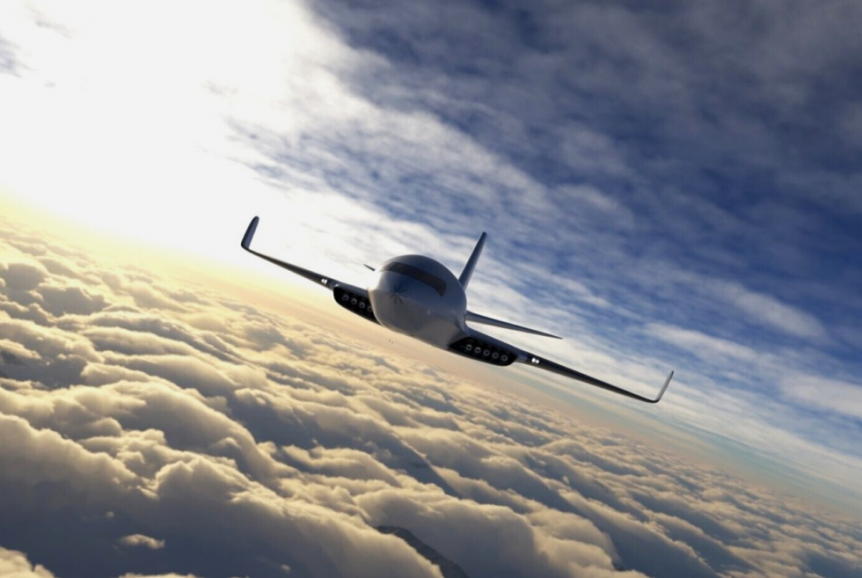Tribolectrics Your editor has long promoted the idea of the Grand Unified Airplane, a vehicle which would essentially power itself from sunlight, piezoelectrics, structural batteries, and even the friction of the air over its surfaces. He wrote about the concept in the May, 2013 Kitplanes, and has noted an increasing number of articles in scientific journals describing a variety of nanogenerators, including tribolectric types. Tribolectrics are not new, having been discovered in the 18th century and initially quantified by Johan Carl Wilcke, a Swedish Physicist in 1757. “Tribo” comes from the Greek for “rub,” and as shown in the following video, even the rubbing of air over a surface can generate electricity. Note that about the 1:25 point Dr. Wang blows across the nanogenerator and lights up the LEDs. Taking that idea and running with it, Warsaw-based designer Michal Bonikowski designed the Eather One to run on electricity generated during the airplane’s movement through the air. As exotic as it …
Load-Bearing Supercapacitors
What if your battery served also as a wing or a fuselage? Several current efforts converge on creating batteries or supercapacitors that could function as structural elements in electric vehicles. We’ve reported on this before, with efforts by Dr. Emil Greenhalgh at Imperial College London and associated work by Volvo to make car components from the type of energy storing sandwich structure he developed. Your editor’s article on the “Grand Unified Airplane” in the July 2013 issue of Kitplanes magazine advanced the idea that such structures, coupled with graphene’s projected capabilities to collect solar energy, could lead to a self-powering aircraft. (In researching the current entry, he found that his idea had been done at model scale by BAE.) Reports from two universities show that others are working toward making that dream less than an idle fantasy. Researchers at Vanderbilt University are making headway toward creating a “Multifunctional Load-Bearing Solid-State Supercapacitor,” as titled in the American Chemical Society’s journal, Nano …
Hail HALE: Boeing’s “Flying Bowling Pin”
On July 12, at its St. Louis, Missouri plant, Boeing rolled out its Phantom Eye high altitude long endurance (HALE) aircraft. Various members of the press and several bloggers took an opportunity to pelt the new plane with sobriquets such as, “flying bowling pin,” or “fat kid,” failing to understand the aerodynamic advantages of the laminar flow fuselage. A quick study of CAFE Foundation references would correct these reporters’ initial impressions. Notwithstanding the apparently controversial aesthetics of the 150-foot span craft, the exciting news for green aviation enthusiasts is its power system – a pair of 15o-horsepower, 2.3 liter Ford Duratec engines, turbocharged and fueled by a “breakthrough” liquid hydrogen system. The long wings, drooping in the press photos, will rise and pull up the flexible struts in flight, a great deal like some of the larger sailplanes of the 1930’s. Sailplane efficiencies apply in this realm, with a projected cruising altitude of 65,000 feet at a speed of 150 …
CAFE Makes the Top of Kitplanes’ Cover
While at the local magazine store, or the proverbial fine book store, you’ll be able to spot Kitplanes’ August 2010 issue easily. The yellow letters on the cover line above the magazine title pop with upper-case intensity: “FUTURE SHOCK: CAFE’S Electric Aircraft Symposium.” Not only does the fourth annual Electric Aircraft Symposium get pride of place on the magazine’s cover and in four pages inside, but Marc Cook, editor-in-chief for the publication, titles his “Around the Patch” editorial “Making Electric Aircraft Exciting,” and proceeds to share his surprised discovery of respect for the new Toyota Prius, and to praise the husband-wife team of Bill Dube’ and Eva Hakansson, battery builder and racer, respectively, of Killacycle, the 0-60 in one second electric motorcycle. At a less-fevered pace, he predicts, “Gone will be the days that we fly at maximum continuous power in cruise….Maximum range comes at lower airspeeds and higher altitudes, one place the electric motor shines…. This will, in effect, turbocharge electric aircraft …
Kitplanes Covers EAS IV
Kitplanes, and its on-line sister, AVweb, covered the fourth annual Electric Aircraft Symposium and generated a vido of the event, which includes a thoughtful interview with Dr. Brien Seeley, CAFE Foundation president. Expect to see more media coverage of CAFE Events as the Green Flight Challenge becomes a major aviation event in 2011.
Hear the Hum? Kitplanes Does.
Kitplanes has an article of great interest to CAFE followers in its November issue. Dr. David Ullman, Oregon State University professor emeritus of Mechanical Engineering Design, was inspired by his attendance at the Third Annual Electric Aircraft Symposium in April to write a two-part article (the finale’ to be in the December issue) about the exciting future of electric flight. The first part, “Hear the Hum?” provides an overview of what’s currently happening in electric aircraft, and includes a one-page pictorial sidbar of volt-driven flying machines at Oshkosh this year by Dave Martin. In a nod to the CAFE Foundation, it includes a concise explanation of the Aviation Green Prize. Ullman and Martin share the belief that we will be flying commercially-produced electric airplanes soon. Dr. Ullman is the author of The Mechanical Design Process, a standard text at many universities, and Making Robust Decicisons, Decision Management for Technical, Business, and Service Teams, and hosts Making Robust Decisions, a Blog …

